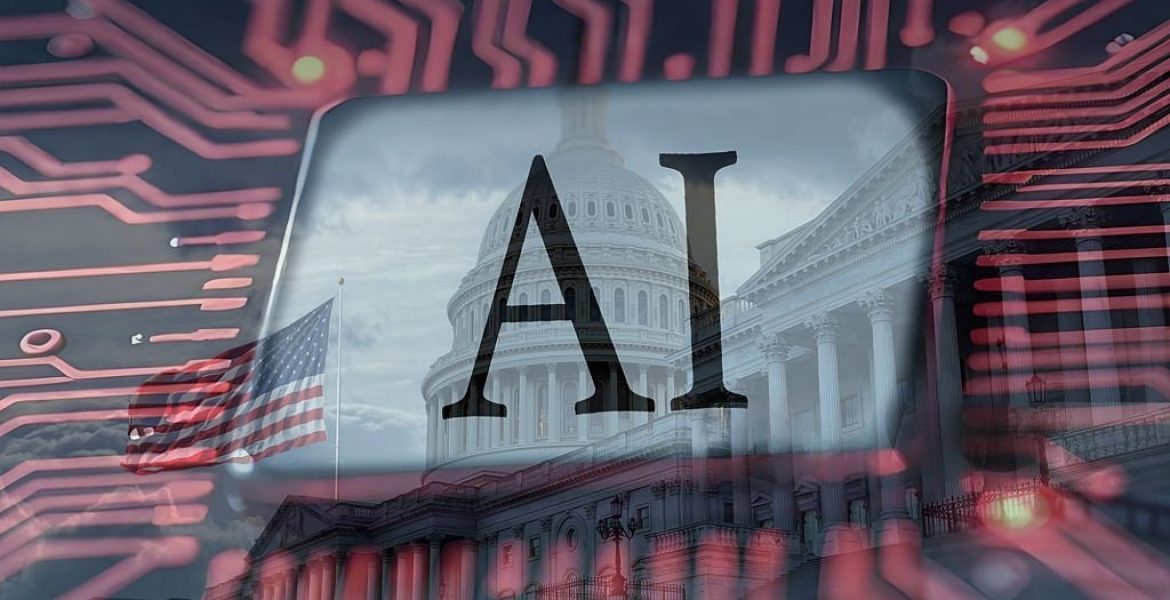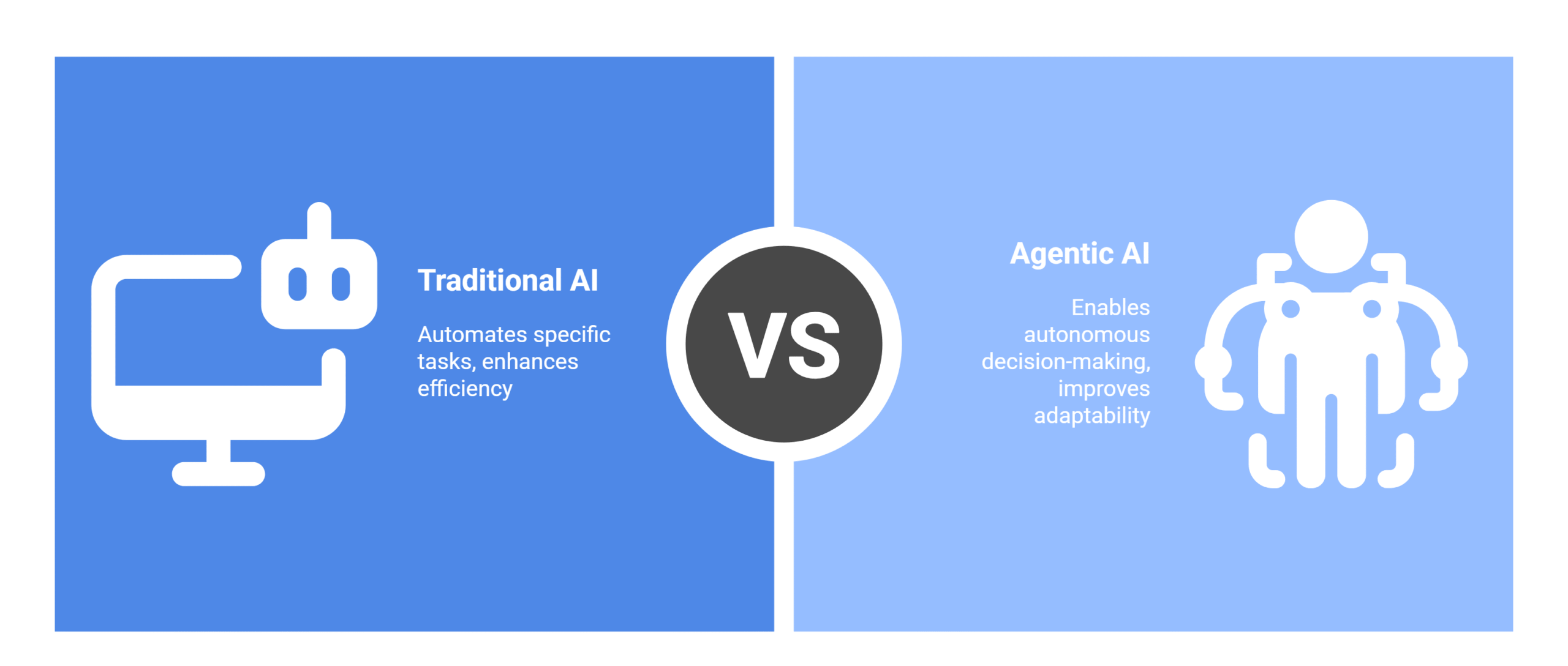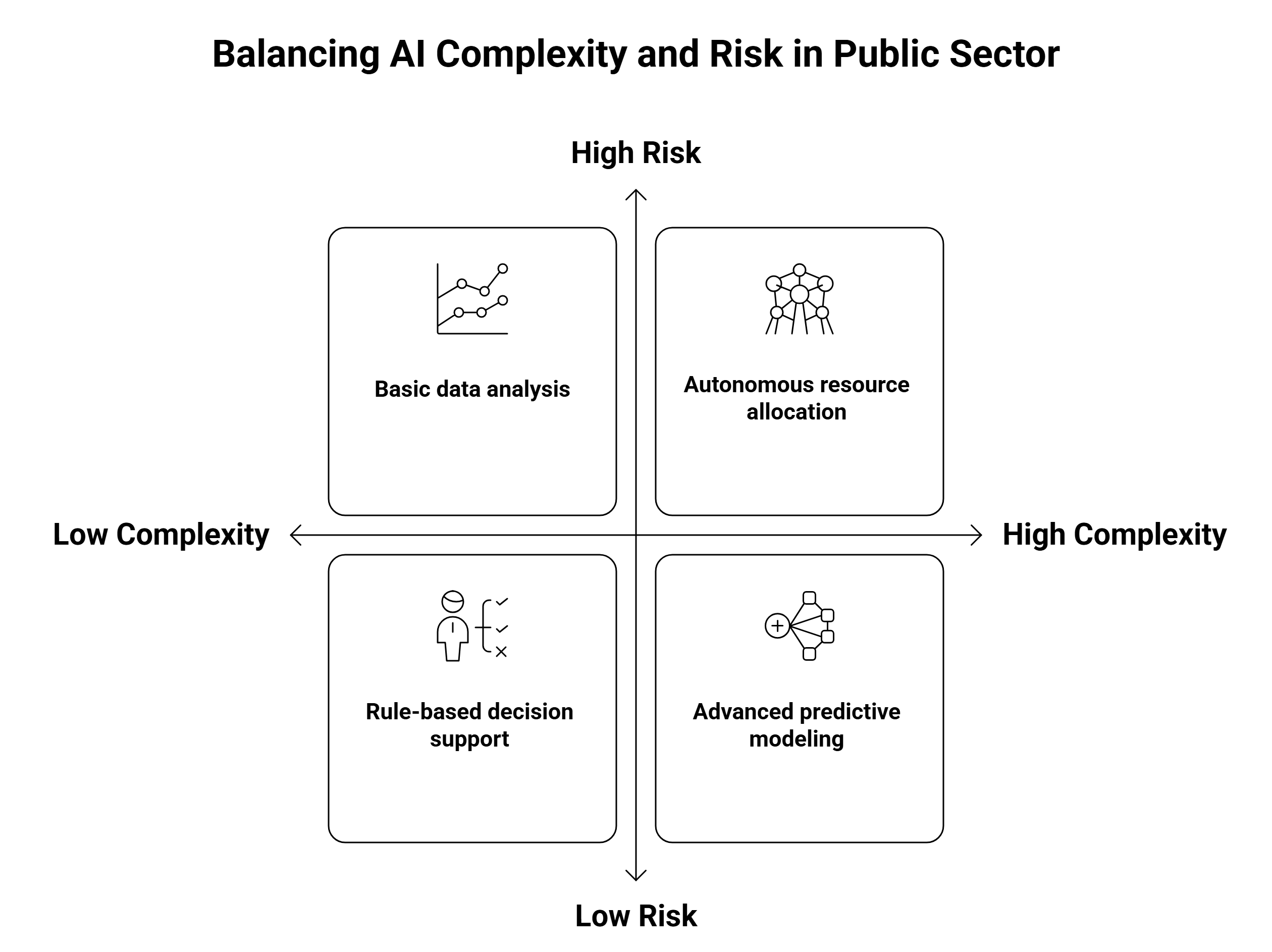

Government technology leaders are hearing a lot of buzz about AI in the public sector, especially new terms like agentic AI. But what do these terms really mean, and how do they affect public services? More importantly, agentic AI vs traditional AI which approach is better for government agencies and their constituents? This article breaks down the differences in an engaging way, with real examples and insights, to help you decide the best path for your public sector organization.
Traditional AI refers to the classic artificial intelligence systems that have been used for years in both private and public sectors. These are typically narrow AI models designed to perform specific tasks based on predefined rules or training data. They analyze input and produce an output, but they do not make independent decisions beyond their programming. In government, traditional AI might power things like automated chatbots for FAQ responses, predictive analytics to forecast trends (e.g. crime hotspots or infrastructure wear), or simple workflow automation for processing forms.
Examples: A rules-based chatbot that answers citizens’ questions about trash pickup schedules, or a machine learning model that predicts which bridges need maintenance. These systems are effective within their scope, but they stick to what they were trained or programmed to do. Many cities have deployed AI to analyze traffic data and optimize traffic lights, reducing congestion. Such a solution is powerful but still traditional AI it follows algorithms without deviating from its specific task.
Benefits: Traditional AI in public service has proven its value in boosting efficiency and accuracy. It can process large data sets to find insights (like identifying tax fraud patterns or optimizing bus routes) and automate routine tasks. Governments use these AI tools to do more with less, an attractive prospect when facing tight budgets and staffing shortages. Gartner predicts that by 2026 over 70% of government agencies will be using AI to assist with administrative decision-making, reflecting growing confidence in traditional AI.
Limitations: Traditional AI lacks adaptability. If conditions change beyond what it was programmed for, it struggles. These systems require new programming or retraining to handle novel situations. For example, a traditional AI chatbot can answer only questions it was scripted or trained on anything outside that, and it fails or hands off to a human. In other words, traditional AI is reactive but not proactive. It won’t initiate an action or learn new rules without human developers updating it.
Agentic AI is an emerging approach where AI systems (often called AI agents) can act autonomously, proactively, and adaptively to achieve goals. Rather than just analyzing input and giving an output, agentic AI can plan, make decisions, and take actions in real time without constant human guidance. Think of it as the difference between a traditional traffic light system and a self-driving traffic manager that reroutes vehicles, adjusts signals, and coordinates with other systems on the fly to optimize city traffic on its own.
In government contexts, agentic AI in government could be revolutionary. These AI agents can handle end-to-end processes and dynamically adjust to new information. A simple way to understand agentic AI is that it’s goal-driven. It understands an objective and continuously works towards it, learning and refining its approach as it goes. For example, imagine a public health AI agent tasked with improving vaccination outreach: it could analyze data to identify under-vaccinated communities, automatically generate targeted communication for those areas using generative AI to draft messages, and even coordinate mobile clinic schedules all with minimal human intervention.
According to one definition, You can define agentic AI with one word: proactiveness, as it does not wait for step-by-step instructions. These systems combine modern AI innovations (like advanced machine learning and large language models) with the classic reliability of rule-based software to achieve their agency. In practical terms, agentic AI can use tools, connect to databases, and interact with multiple systems automatically. It can even refine its own goals based on feedback, something traditional AI won’t do.
Examples: In the public sector, agentic AI might autonomously reconfigure a supply chain for emergency supplies in response to a natural disaster without waiting for officials to intervene. Or consider permitting and compliance: a traditional system might flag applications with missing information, but an agentic AI system could proactively reach out (via email or chatbot) to the applicant for data, update the application, run compliance checks across databases, and approve or escalate automatically. Agentic AI agents are already being developed for compliance checks, case processing, and smart alerts in government workflows. These intelligent agents can monitor a procurement process end-to-end – verifying vendor credentials, flagging risks, and initiating communications to keep everything on track without a person micromanaging each step.
Benefits: The promise of agentic AI for public services is huge. It can augment staff by offloading routine drudgery faster than humans, letting employees focus on mission-critical work. Early evidence suggests agentic systems can dramatically speed up processes. For instance, an autonomous AI agent might process service requests or analyze data across departments in a fraction of the time a human team would take. By breaking down silos and working 24/7, such agents help agencies respond to citizen needs more rapidly. Agentic AI is like an ultra-efficient digital staff member who never sleeps, constantly optimizing operations. Gartner foresees that by 2028 about 33% of enterprise software applications will include these next-gen AI agents (up from less than 1% in 2024), indicating how transformative agentic AI could be across industries including government.
Challenges: Giving AI this level of autonomy raises important considerations. Agentic AI systems require careful oversight and well-defined boundaries. In government, strict rules and ethics must be upheld; an AI agent must act within legal and moral guidelines, sometimes called “within strict operational parameters of the mission.” There’s also a higher risk of unintended outcomes if an autonomous AI makes a poor decision, especially in sensitive areas like public safety or healthcare. Thus, while an agentic AI can take initiative, public sector leaders need to ensure these systems are transparent, fair, and accountable. Many experts suggest starting with agentic AI in assistive roles (e.g., decision support) rather than fully automating high-stakes decisions until robust governance is in place.
To clearly see how agentic AI vs traditional AI stack up, let’s compare their characteristics side by side:
| Aspect | Traditional AI (Narrow AI) | Agentic AI (AI Agents) |
|---|---|---|
| Autonomy | Reactive – only responds to user input or preset rules. Does not act independently. | Proactive – operates independently, can initiate actions without waiting for commands. |
| Adaptability | Limited learning scope; needs retraining or reprogramming to handle new scenarios. Sticks to what it knows. | Highly adaptive; learns from feedback and experience, adjusts strategies in real time, and can handle changing conditions. |
| Task Scope | Designed for specific tasks or narrow domains (e.g. a chatbot or a fraud detection model). Struggles with multi-step processes. | Capable of managing complex, multi-step workflows and even juggling multiple goals. Can coordinate several tasks to reach an overarching objective. |
| Interaction | Operates in isolation; takes input and gives output in a single context. May require human to connect dots between systems. | Integrates with multiple systems and tools (APIs, databases, software). Can call external services or other AI models as “helpers” to accomplish goals. |
| Examples in Government | Chatbot answering FAQs on a city website; ML model predicting which bridges need repair; automation script routing forms to the right department. | An AI agent that handles permit applications end-to-end; a multi-agent system monitoring city infrastructure and autonomously scheduling repairs; an intelligent assistant that analyses legislation, drafts summaries, and schedules relevant meetings automatically. |
In summary, traditional AI is like a specialist very good at the specific job it’s trained for whereas agentic AI is more of a general problem solver that can take on a broader mission, figure out the steps, and carry them out with some level of self-direction. For public service leaders, the key difference lies in how much initiative and adaptability you want your AI systems to have.
You might be wondering, where does generative AI in public service fit into this picture? Generative AI think of models like GPT-4 or DALL-E is a subset of AI that can create new content from text and images to even code. It actually complements both traditional and agentic AI approaches:
In short, generative AI is a powerful new tool in the public sector’s toolkit. It can be deployed on its own in a traditional manner for instance, a standalone chatbot that generates answers using an LLM or as part of an agentic system an AI agent that not only plans actions but also generates content or code as needed to fulfill its mission.
Government tech leaders should keep an eye on generative AI’s rapid evolution, as it directly contributes to more conversational citizen services and faster document processing both of which are high priorities in public service modernization.
When deciding what’s better for public services, consider the goals and challenges of your agency. Both traditional and agentic AI have roles to play, and each offers distinct benefits:

Traditional AI helps governments save time and money by automating routine tasks like processing permit applications or scanning CCTV footage. Agentic AI goes further by automating entire processes verifying documents, cross-checking databases, approving simple cases, routing complex ones, and notifying citizens. This end-to-end automation can drastically reduce processing times.
Both AI types analyze big data for smarter decisions, such as allocating police patrols. Traditional AI surfaces insights, while agentic AI acts on them in real time. For instance, a health AI could predict flu outbreaks and automatically launch awareness campaigns or reallocate resources. Continuously learning and adapting, agentic AI acts as a digital team member spotting and handling issues before they escalate, improving responsiveness in areas like emergency management or city maintenance.
Traditional AI provides standard responses to all users, while agentic AI tailors interactions. For example, instead of static bus schedules, an AI-powered transit assistant could learn a commuter’s habits and send personalized alerts like alternative routes when delays occur. This personalization boosts citizen satisfaction and trust in digital services, helping governments become more citizen-centric.
Governments operate in silos health, licensing, courts, etc. Traditional AI optimizes within one silo, but agentic AI can bridge them by interacting across systems. For example, an AI agent could combine education, health, and law enforcement data to identify at risk youth and coordinate interventions. This cross-system orchestration, while requiring data-sharing safeguards, is a key strength of agentic AI.
Public sectors often face staffing shortages. Traditional AI assists with tools, but agentic AI acts like an extra team member handling routine tasks and requests. This allows staff to focus on work requiring human judgment or empathy. The result is improved productivity, better morale, and faster public service response times.
While the advantages are exciting, government leaders must weigh practical challenges when choosing between traditional and agentic AI solutions:

In conclusion, the choice between traditional AI and agentic AI depends on your agency’s goals and readiness. Traditional AI is ideal for structured, efficiency-driven tasks like automating workflows or managing citizen queries, while agentic AI represents the future of adaptive, collaborative governance—perfect for complex, dynamic challenges such as emergency response or real-time city management. Often, a hybrid model combining both offers the best results. If you’re a public sector leader ready to explore the power of AI, App Maisters Government Services can help you design and deploy tailored AI strategies that enhance efficiency, accountability, and citizen engagement. Visit App Maistets Government today to start transforming your digital government vision into reality.
Agentic AI is proactive and goal-driven, capable of making independent decisions and adapting to new information, while traditional AI follows pre-set rules and needs human prompts for each task. App Maisters, ISO 9001 and ISO 27001 certified, develops both solutions for government agencies, ensuring secure and compliant AI in public sector operations.
Agentic AI can automate entire workflows, coordinate across systems, and personalize services for citizens, unlike traditional AI, which typically handles single, narrow tasks. App Maisters specializes in building such systems for the public sector, enhancing efficiency and citizen engagement.
Yes. Generative AI in public service is often integrated within agentic AI to create personalized content, automate reports, and improve communication. App Maisters delivers generative AI-enabled agentic systems to help agencies streamline citizen services securely.
Absolutely. As an ISO 9001 and ISO 27001 certified provider, App Maisters ensures all agentic AI and traditional AI solutions for government agencies meet strict security, quality, and regulatory standards.
Commodo elementum, sed imperdiet nunc euismod etiam aliquet viverra

App Maisters Inc is a Federal Government SBA 8(a) Certified and Texas Hub Certified company. We are a leading developer of high-performance mobile apps, websites, and enterprise solutions, that are specially designed to meet Federal, State, Local government agencies and higher education needs.
